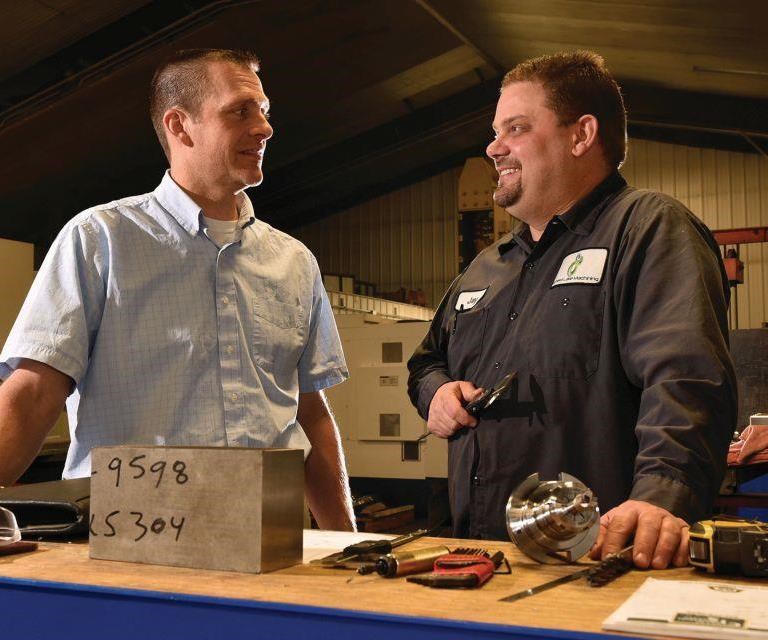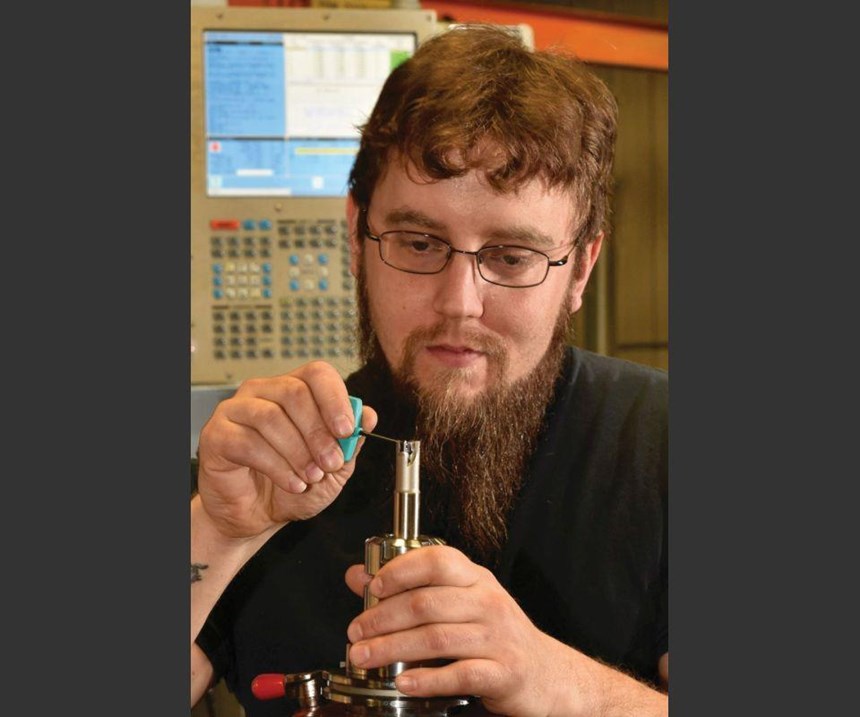Rethinking Standards for One-Offs
Orchard Lake Machining's standard mill used to rupture 10 minutes into the cut. Ingersoll's Di-Pos Tetra mill increased tool life and operator productivity.
Share





For many small shops, shopping for a costly new tool to produce a single workpiece with an uncertain reorder prospect does not make sense. Instead, production engineers look at the part print and settle for the cutter already in the tool crib or carousel, and estimators bid work based on the tooling their shops use as standard. When Orchard Lake Machining decided to try a new tool from Ingersoll Cutting Tools for a one-off application, however, it led to a new standard used throughout the shop floor.
The busy, four-man shop in Williamsburg, Michigan, specializes in machine components for the oil and gas industry. There, three machinists try to keep five CNC machines running 10 hours a day, five days a week on a variety of small-lot and one-off jobs. One such job required heavy contour-milling of 302 stainless. Initially, the shop used its standard IC mill inserts; however, these inserts usually ruptured about 10 minutes into the cut. Often, the first edge fractured, which rendered the second edge useless. Retooling with a Di-Pos Tetra mill from Ingersoll (Rockford, Illinois) extended edge life to more than two hours per edge and eliminated all rupturing. This ensured eight full hours in the cut per insert. “We now index the insert only due to gradual flank wear and loss of finish, never for anything catastrophic,” says owner and CNC manager Jay Johnson.
The idea to retool this application was the result of a regular shop walk-through by Ingersoll’s Ed Tichelaar. He spotted the opportunity when the part was running—or more accurately, when it was stopped for tool service. Mr. Tichelaar also noted that servicing the ruptured tool tied up an operator who could have been working on another machine.
The job at hand involved milling a thick, F-shaped machine component used in oil-patch machinery out of a 9-by-6-by-4-inch solid block of 304 stainless steel. Running on a Haas VF 5 50-taper CNC vertical machining center, the block loses about half its weight to chips during the milling process.
Previously, Orchard Lake used a standard 5/8-inch, two-insert IC mill at 400 sfm, 30 ipm and 0.060-inch depth of cut (DOC) for the job. The tool worked fine on other jobs, so it had become the shop standard for contour milling. However, since the inserts ruptured so frequently on the stainless job, often on the first edge, Mr. Johnson says the shop was essentially machining with a single-edge insert. Running any faster was out of the question.
He agreed to a trial right on the job because the change involved a simple drop-in replacement and Mr. Tichelaar had a sample tool with him. Under identical conditions, the Di-Pos Tetra mill lasted two and a half hours in the cut per edge. Considering all the rupturing on the first edge with the previous tool, and the four edges per insert on the new one, this amounted to 60-to-1 increase in insert life.
Though a relative newcomer to the Ingersoll line, the Di-Pos Tetra had been proven out with early users milling a wide range of alloy steels, stainless and superalloys. In addition to standard contour milling, it had also improved slotting and corkscrew milling holes from the solid, so Mr. Tichelaar was confident in his recommendation for the stainless job at hand.
The tool was not cheap, and the job was only a one-off, but Mr. Johnson immediately recognized the larger potential. “Yes, we reduced maintenance, repair and operations cost on the stainless part, but the larger payoff was freeing the operator to keep the other machines earning more,” he says.
Orchard Lake bought the demo tool on the spot and completed the part using the same parameters as the previous cutter. “I had a hunch we could have run it faster without sacrificing edge life, but we were on a learning curve,” Mr. Johnson says. “Longer tool life and hands-off operation were enough this first time. I’m sure we’ll ramp up the material-removal rate next time.”
The ramping-up is already underway. Based on results with the stainless job, Orchard Lake quickly switched over to the new mill for a variety of alloy steel and titanium jobs, pushing the removal rates as it went. In fact, the Di-Pos Tetra mill is now the company’s tool of choice for rough and finish contour milling on all metals except aluminum. Adapting it to the other materials simply involved switching among different application-matched inserts. In all cases, indexing has averaged one minute at most.
According to Mr. Tichelaar, available inserts for the Di-Pos Tetra mill cover cast iron, steel, nickel steels and stainless steel. He says its just a matter of time before inserts for aluminum are added to the line.
Several unique features contribute to the Di-Pos Tetra’s success in heavy contour-milling. First, as the name suggests, the tool boasts positive cutting geometry both radially and axially, creating an extreme free-cutting action and low cutting forces that protect the tool and machine. “It’s more a cleaving than scraping action,” Mr. Tichelaar says. “The tool simply slices through superalloys with a very quiet cutting action.”
The cutter also uses large, sturdy inserts and an extra-rigid clamping system for stability, even in the face of deep, interrupted cuts. The four-edge inserts have a 0.240-inch axial DOC capability, and an aggressive ramping angle for corkscrew milling and fast cornering in extreme contouring applications, Ingersoll says. Wiper flats improve surface finish. Proprietary coatings reduce friction for lower cutting forces and cooler running.
“The larger payoff is that our estimators can bid more competitively for new work based on the better shop economics created by the new tool,” Mr. Johnson says.
Mr. Tichelaar credits Mr. Johnson with investigating the new tool that has become the shop’s new standard. “He was able to look beyond the job at hand to figure the payback.”
Related Content
The Future of High Feed Milling in Modern Manufacturing
Achieve higher metal removal rates and enhanced predictability with ISCAR’s advanced high-feed milling tools — optimized for today’s competitive global market.
Read MoreQuick-Change Tool Heads Reduce Setup on Swiss-Type Turning Centers
This new quick-change tooling system enables shops to get more production from their Swiss turning centers through reduced tool setup time and matches the performance of a solid tool.
Read MoreSelecting a Thread Mill That Matches Your Needs
Threading tools with the flexibility to thread a broad variety of holes provide the agility many shops need to stay competitive. They may be the only solution for many difficult materials.
Read MoreHow to Troubleshoot Issues With Tool Life
Diagnosing when a tool is failing is important because it sets an expectation and a benchmark for improvements. Finding out why gives us a clue for how to fix it.
Read MoreRead Next
5 Rules of Thumb for Buying CNC Machine Tools
Use these tips to carefully plan your machine tool purchases and to avoid regretting your decision later.
Read MoreRegistration Now Open for the Precision Machining Technology Show (PMTS) 2025
The precision machining industry’s premier event returns to Cleveland, OH, April 1-3.
Read MoreSetting Up the Building Blocks for a Digital Factory
Woodward Inc. spent over a year developing an API to connect machines to its digital factory. Caron Engineering’s MiConnect has cut most of this process while also granting the shop greater access to machine information.
Read More





















.png;maxWidth=300;quality=90)















